An uneasy border: How the "Russian world" has encroached on Ukrainian border villages via Belarus
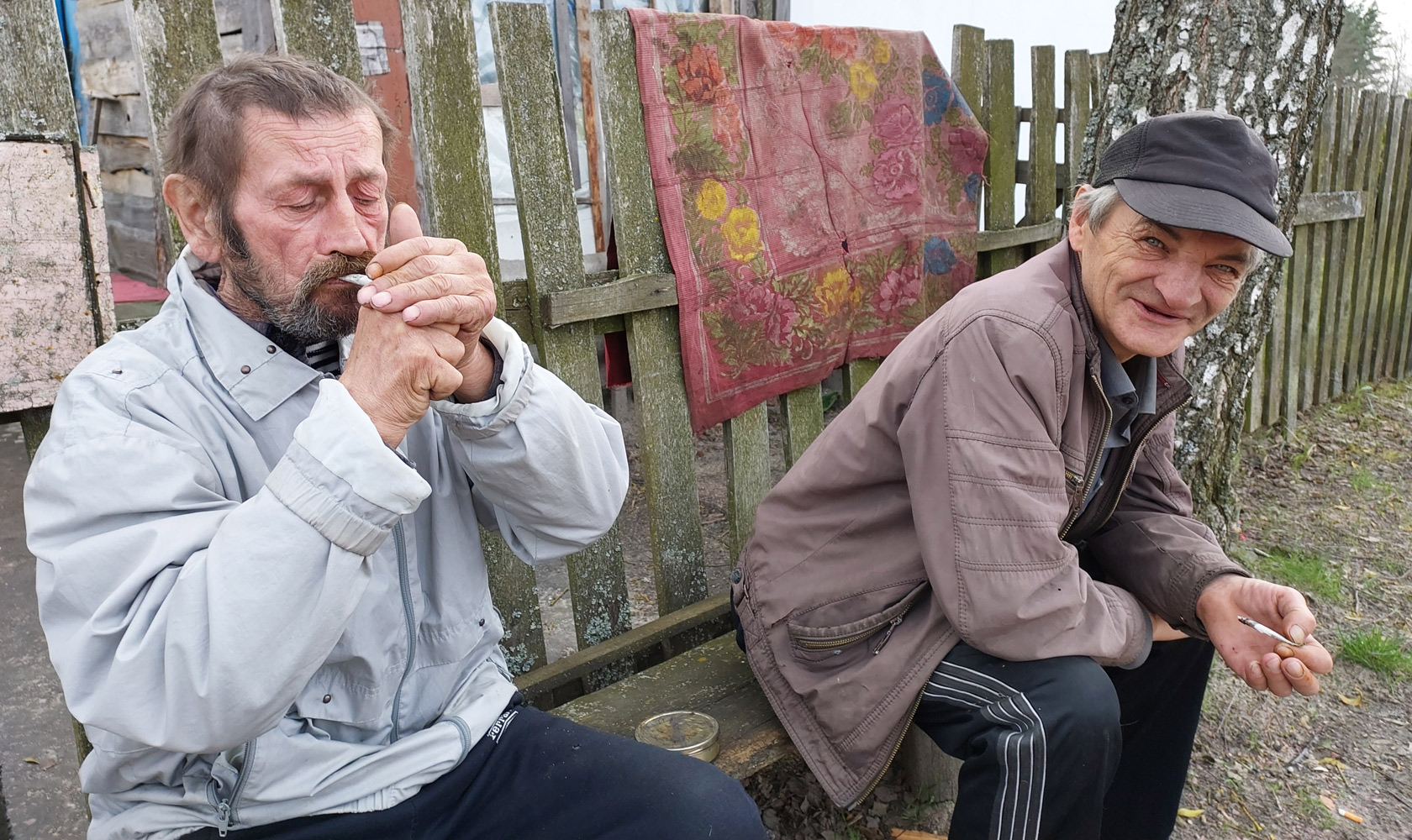
In the early hours of 24 February 2022, the village of Kopyshche, near the Ukrainian-Belarusian border, was unusually busy. In almost every house, people were gathering: getting their tractors and walk-behind tractors started, hitching up trailers, harnessing horses, running their cars to warm them up.
People were loading warm clothes into their vehicles, bringing out preserves, grains and salo [cured lard – ed.] from their cellars, packing tents, blankets, tarpaulins, wooden planks and wood they had prepared for their stoves. They worked quickly and without fuss.
The women were the first to break down and start crying quietly. The children were quiet and subdued. The men were focused. People avoided turning the lights on unless absolutely necessary, trying to get by in the dusk using only their sense of touch. The women and children climbed on top of all the goods they had piled into their trailers and carts, and the people set off. The procession of families who had left their homes stretched all the way to the forest.
What was happening? War.
The people of the village of Kopyshche were fleeing to the nearby forest. They didn’t know exactly where they were going, or for how long, but they knew they had to hide in the forest. The forest would protect them: this truth is inscribed in the villagers’ collective memory on a genetic level. It was inscribed there on 13 July 1943, when the Germans killed most of the villagers in an act of reprisal: only those who fled to the forest survived.
During Soviet times, the people of Ukraine and Belarus were often called "brotherly nations". This propagandist-coined metaphor made sense to an extent, especially in the border areas. At the time, the borders between the Soviet republics were nominal, and cultural and linguistic similarities were conducive to close ties.
Now, however, the Belarusian government’s support for Russia’s aggression against Ukraine has divided the two peoples. The north of Ukraine seethes with tension: will the Russians try to cross this border once again? Will Lukashenko [Alexander Lukashenko, the self-proclaimed president of the Republic of Belarus - ed.] send his army to fight, or allow Russia to deploy its nuclear weapons in Belarus?
We travelled to some of the villages near the Ukrainian-Belarusian border to understand how the Russian invasion on 24 February 2022 has changed the lives of the people who live there. Did the locals welcome the "Russian world" that was encroaching on them from Belarus? How do they maintain relationships with family members on the other side of history?
I visited three border areas in Zhytomyr and Rivne oblasts, gathering three stories – each one distinctive in its own way.
What is absent from this piece is a focus on the Ukrainian army, which does of course have a presence at the border. Checkpoints, document checks, minefield warning signs, fortifications, combat engineering – all this is there, well protected from outsiders’ eyes. So I’ll keep quiet about all that.
"Around lunchtime, they started firing from the football pitch"
Radcha, Narodychi hromada, Zhytomyr Oblast (1.2 km from Belarus)
Around 400 people live in the seven villages of the Radcha village district, which is part of the Narodychi territorial hromada. The Radcha district borders the Chornobyl Exclusion Zone, whose residents were evacuated following the 1986 disaster.
Over the 37 years since then, time has eroded the empty villages in the exclusion zone, the forest has obscured the traces of human life, and the residents only visit their former homes once a year, to tidy up their relatives’ graves on remembrance days. In the abandoned villages, the cemeteries seem like the most alive places.
Raisa Kulak, 74, who lives in Radcha, moved there after the nuclear disaster. I asked her what she thinks about Putin and Lukashenko’s threats to deploy nuclear weapons in Belarus, given her close encounter with radiation.
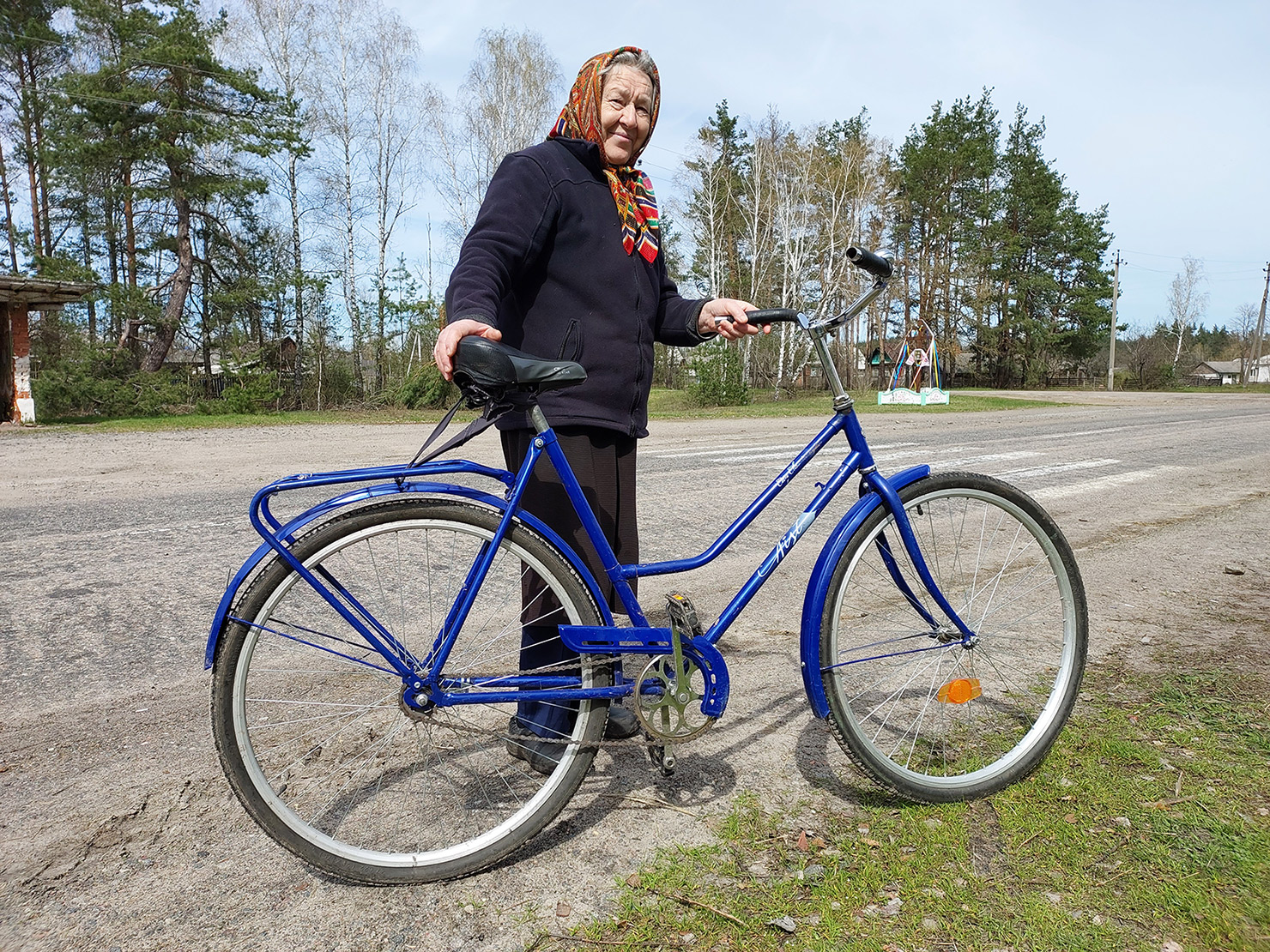
"We already know how the Russians fight," Raisa notes ironically. "Their missiles crash in their own cities because they don’t know their arse from their elbow. What if nuclear missiles in Belarus start crashing and exploding? Of course we’re worried – we don’t need any more radiation."
Last year, Radcha was occupied by Russian forces.
"The war started at 04:30. We were shelled. By 09:00 everyone knew: no one would be able to enter or leave the village – there were Russian checkpoints on all of the roads," says Iryna Nevmerzhytska, a Radcha village official. "Three residents of our village were killed and three were injured during the month of Russian occupation. It was scary – especially if you saw a Russian soldier walking towards you. We didn’t know what to expect from them. It was scary to see the missiles that were flying over the border and into Ukraine."
The road to the Belarusian village of Aleksandrovka passes not far from Radcha. It was one of the roads Russian troops used to enter Ukraine as they advanced towards Ivankiv, a city in the north of Kyiv Oblast, and then Kyiv.
For three days, the roar of heavy military vehicles resounded throughout Radcha. A Russian garrison was stationed in Radcha and the nearby village of Hrezlia. All through March 2022, the Russians engaged in positional battles – mostly involving artillery – against the Armed Forces of Ukraine. Guns thundered, the villages were hit by shells, and people’s houses caught fire.
That was the early phase of the war when the Russians were eagerly proclaiming propagandist clichés along the lines of "we bring peace" and "we’re here to defend you". The world did not yet know about the atrocities Russian troops would commit in Bucha and Mariupol.
Raisa kept a diary. She captured all 36 days of Radcha’s occupation and the fighting that was taking place in Ukraine’s northern Polissia region – which could be seen and heard in the village – in her neat and concise writing on 12 pages of a plain school exercise book. Here are some excerpts from her diary:
"5 March. Aircraft seen in the morning. At 10:30 tanks drove into the village and opened fire, then the Grads [multiple-launch rocket systems – ed.] started pounding. They hit Lena Stepurenko’s barn and ripped a piglet apart. Her cow survived. The fire in the barn was extinguished. Abramykha’s house burned down. Shells were falling all around."
"14 March. Tanks positioned at the crossroads were firing. Many people left the village during the day and in the evening."
"26 March. Only occasional shelling. Tania was buried. I found out that Liuda and Yura – we called them the Budulais – were killed. They were buried separately, in Radcha. No one knew what happened…"
"30 March. They were pounding with great force from early in the morning. Then they fired up to 20 rockets on Korosten. Then there were helicopters in the air, they were striking, machine guns were firing, tanks were firing too. Everything was shaking. There was a short break. In the evening they deployed Grads three more times, and tanks fired on Narodychi. A fire broke out…"
Many residents of Radcha have relatives in Belarus. What was their reaction to the war? It varied. Some, zombie-like, repeated propaganda narratives along the lines of "You have a civil war going on in Ukraine, you’re fighting against your own people, and Putin is a saint." Others were distressed, saying they would pray for Ukraine and would rather go to prison than be forced to fight against "our brothers, the Ukrainian people".
"My sister lives in Belarus. She and I had a fight because of the war," said Halyna Butkovska, a paramedic from Radcha. "She called me a Banderite [a follower of Stepan Bandera (1909–1959), the leader of a radical faction of the Organisation of Ukrainian Nationalists – ed.] and said that everyone who was against Putin was a Banderite. This was my own sister, born here in Ukraine, saying that! She trusts her TV more than she trusts me. But my Belarusian friends support us – they called us on the very first day and apologised for the fact that there was nothing they could do for us."
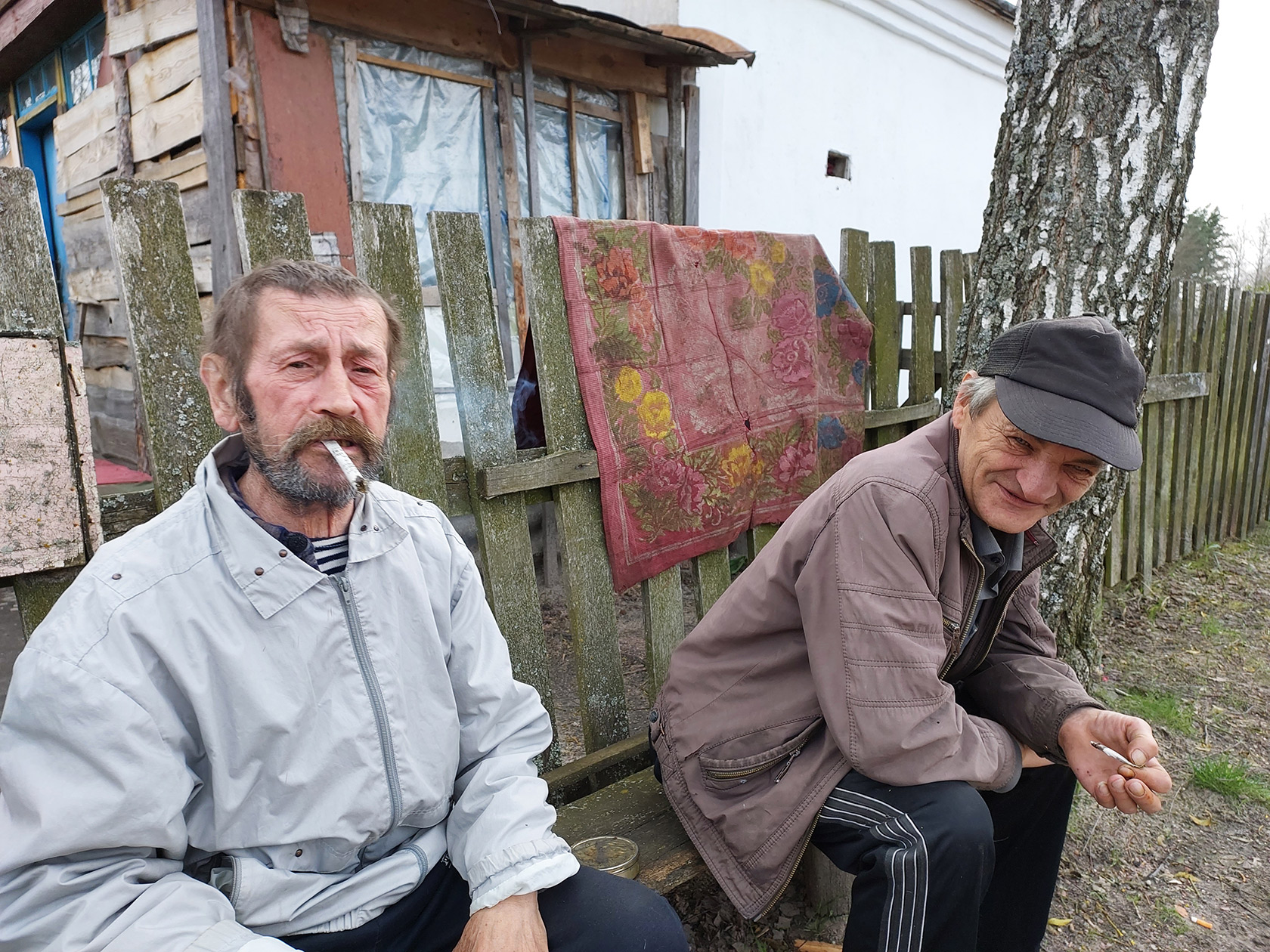
I got talking to two men from Radcha, Volodymyr and Oleksandr. They both recalled the beginning of the war, hiding from the shelling and not knowing what was happening in the rest of the world. The only reports they got about the war were the ones inscribed in the skies: the aircraft, helicopters, and the white traces of missiles launched on Ukraine.
They told me that this year’s flood was a particularly generous one: they haven’t seen the water rise so much in the past 10 years. The rivers overflowed their banks and flooded meadows, fields and gardens.
"When the water goes down, I’ll finish the dugout at the back of the garden," Volodymyr said under his breath.
"What do you need a dugout for?" I asked him.
"The war’s still going on! What if they come here again? What if they burn my house down?"
Oleksandr added: "Floods are good: the marshes will fill up again, and the Russians will definitely not try to get to us through Belarus. Unless they’re complete idiots, of course."
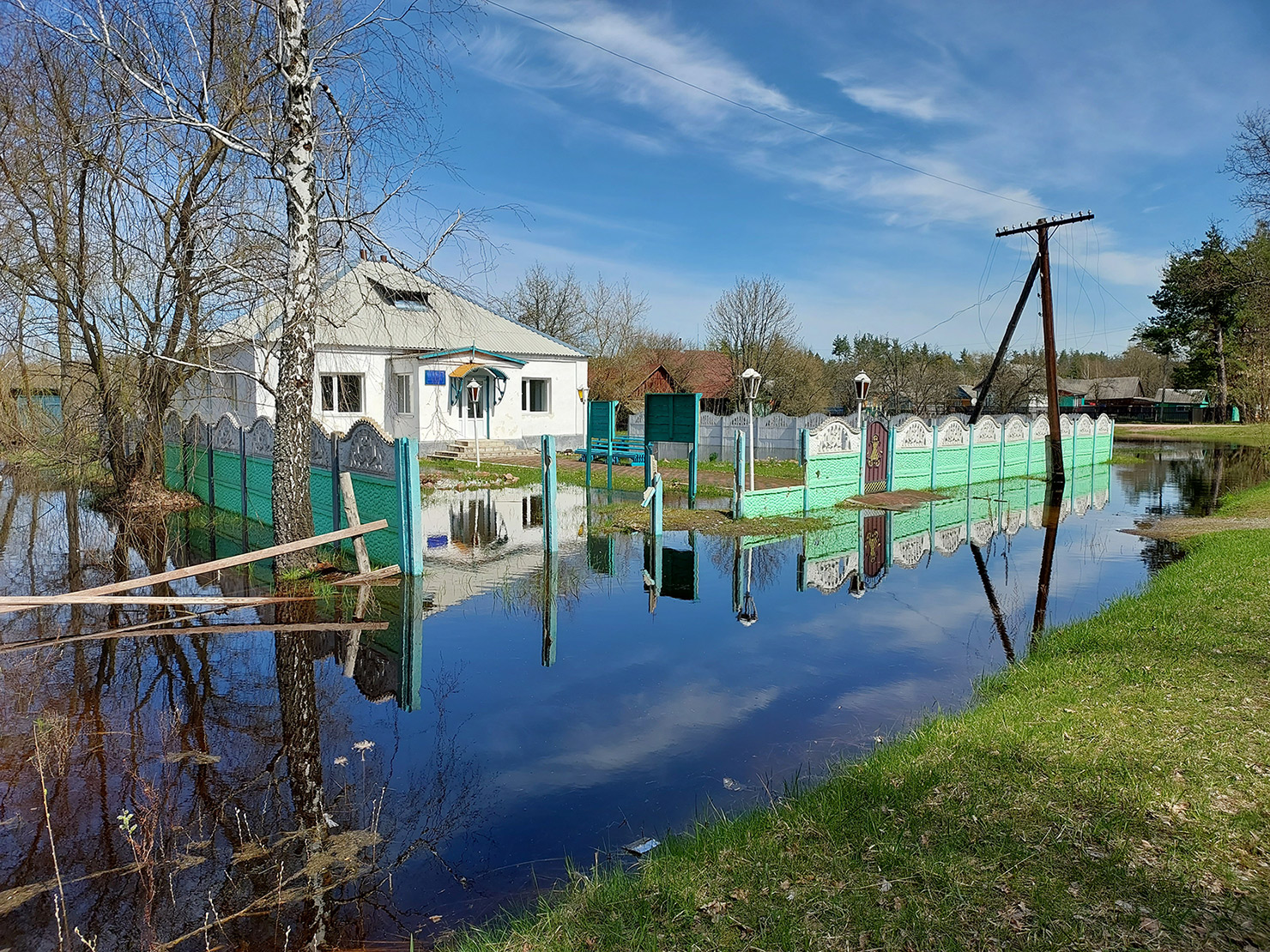
A striking detail: just over 200 people currently live in Radcha. Before the Russian occupation, almost every household kept pigs, and the villagers kept four cows. Now there are almost no pigs left and only one cow. The animals that were there before the war have been killed for meat, or died. The occupation, displacement and shock also caused people to miss the right time for buying young pigs to fatten them up.
The war has derailed most of the villagers’ customs and routines. How soon will they be able to return to their former way of life? Will they ever?
Those who fled to the forest survived
Kopyshche, Olevsk hromada, Zhytomyr Oblast (0.5 km from Belarus)
The village of Kopyshche is surrounded by Belarus on three sides. After the collapse of the USSR and the appearance of border outposts, patrols and customs control, local residents were allowed to cross the border and enter the neighbouring country’s territory under a simplified procedure – "by appointment"; they had to return by the end of the day.
Any borderland is always alive with mutual trading benefits when you can buy something cheaper or better in the neighbouring country. For instance, the Ukrainians appreciated Belarusian dairy products. The Belarusians, on the other hand, liked Ukrainian confectionery, stationery and school supplies, as they are cheaper in Ukraine. And I’m told they bought up our school uniforms, especially girls' uniforms – colourful jackets and pretty skirts – because Belarus was producing outdated school uniforms at the time.
Were the Belarusians and Ukrainians there jealous of each other? Yes, there was a little bit of that, because your neighbour always has something better than you.
"We always noticed that the Belarusians have good roads," recollects Mykhailo Mykhalets, the head of Kopyshche. "They were jealous of our free economic relations. In fact they’ve preserved the Soviet collective farm system. They have to submit plans for their crops: how much the village has to give to the state and which crops. We have private farming and they don’t.
In Kopyshche, there are more than a hundred tractors in private households; they can't even dream of that. But in their village, which is two kilometres away from us as the crow flies, a magnificent community arts centre was built at the state’s expense – something we can't even dream of here."
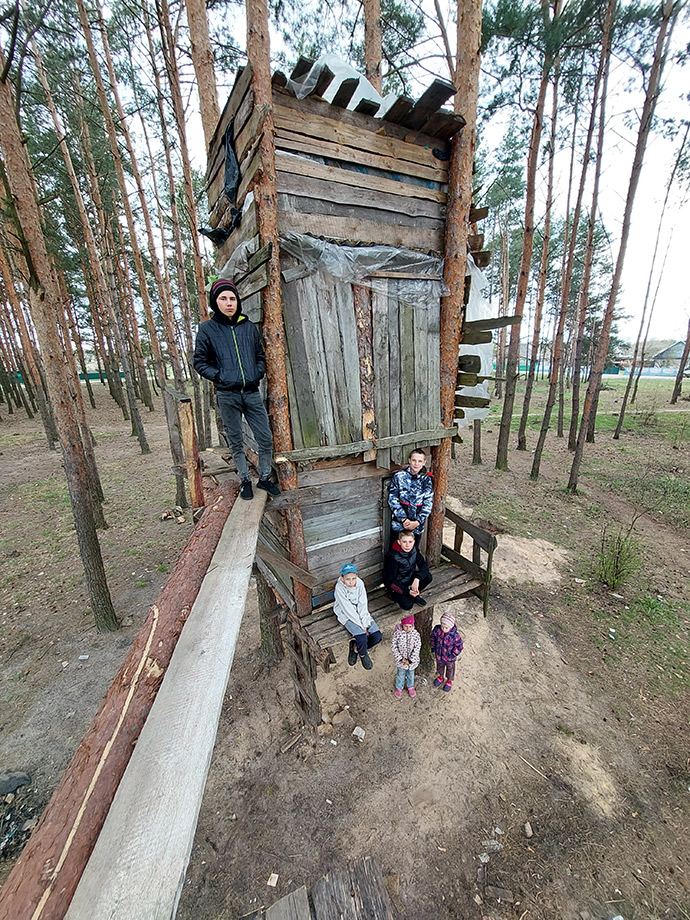
About ten years ago, the residents of Kopyshche began to notice depression and fear in the Belarusians when they interacted with them.
"Once, when I was out fishing, a friend of mine when I was young, who’s Belarusian, was being very quiet, and then suddenly he grabbed his phone and mine and took them to the car. He came down to the river again, and only then did he start talking and being honest. I laughed and said: ‘What's wrong with you?’ But he was quite serious: ‘What if the KGB is listening to us?’ They can do it even if the phone’s switched off, he said," recounts Oleksandr Adamovych, a resident of the neighbouring village, Khochyne, whom I met in Kopyshche.
The pandemic abruptly cut short the already weakening contact with the nearby border. Local checkpoints were closed. And then Covid was replaced by the large-scale invasion, attacks on Ukrainian cities by Russian jets taking off from Belarusian airfields, and nuclear blackmail.
"Why don't Belarusians speak out against nuclear missiles on their territory?" I ask.
"They don't speak out about anything at all any more," says Oleksandr. "They tried in 2020, but Luka [President Lukashenko – ed.] discouraged them from protesting and they went quiet. But they don't want nuclear missiles, and neither do we. They realise that Ukraine is already angry with them for letting Russian troops through. They’re afraid that we might be keeping quiet now, but one day we’ll respond. And we won't bother trying to figure out who’s Russian and who’s Belarusian."
An interesting historical detail from World War II: in 1943, during a punitive operation in Kopyshche, the Nazis burned 2,887 people alive, including 1,347 children, out of the then 4,000 inhabitants. Most of those who survived had been warned by partisans.
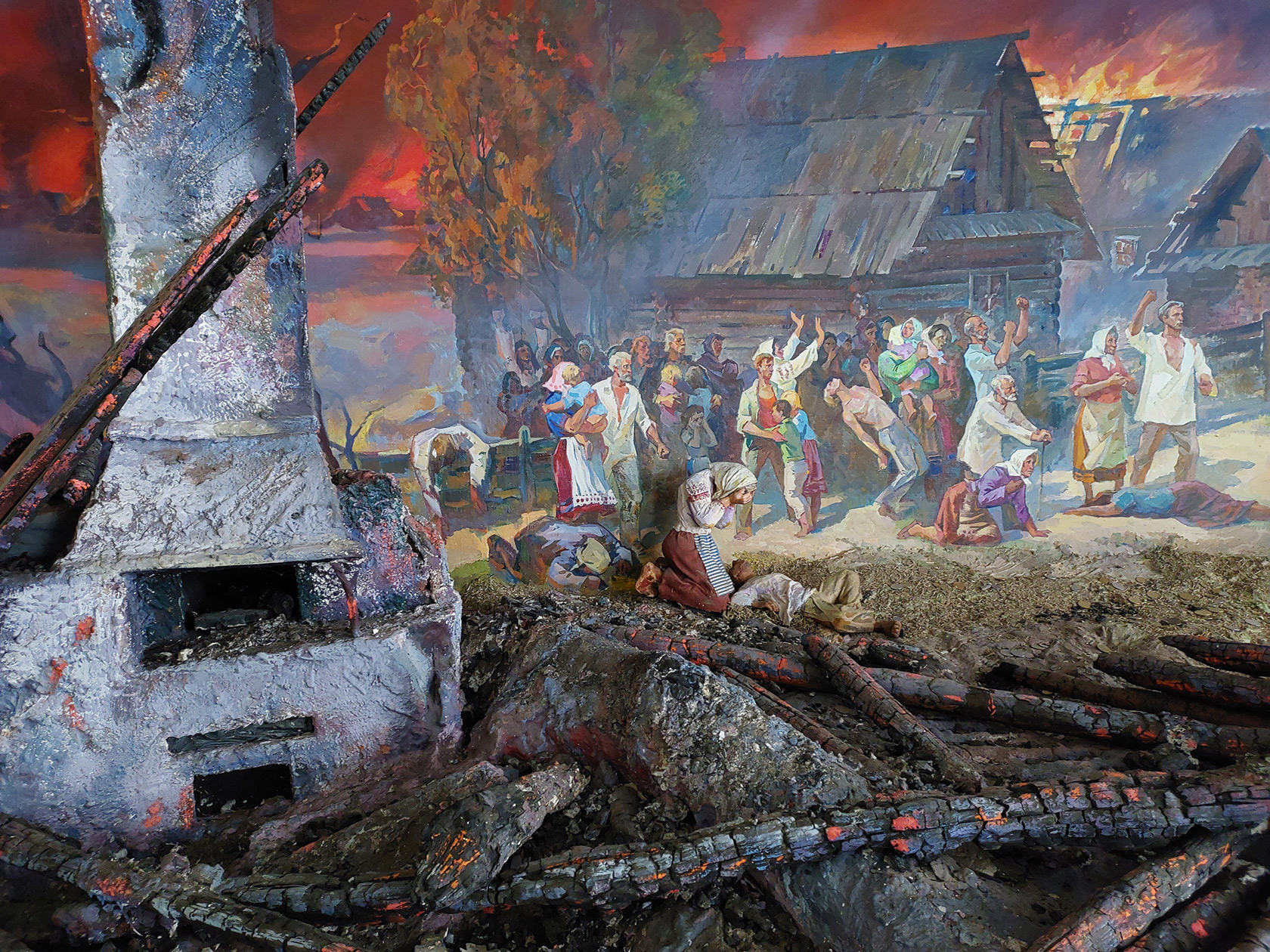
Kopyshche had a population of about 1,000 when the 2022 war started. Border guards warned the villagers about the impending invasion by Russian troops from Belarus an hour before it began, when they themselves received orders to evacuate away from the border.
When the locals saw the border guards leaving, they wasted no time packing everything they thought they would need and fled with their families to the forest. To the forest, where they know every path, ditch and marsh: the forest feeds them, and it would shelter them.
These people had no clear plan – they just wanted to get away from the roads, which are the most dangerous places to be during an attack. They thought they would stay in the forest for a few days – they brought firewood, shovels, tents and warm clothes. They didn't set up a large camp – they gathered in small groups, made fires, slept and kept watch. The phone connection was becoming unreliable, so they got their information about the war by word of mouth. And they counted the Russian jets and missiles overhead.
They stayed in the forest for three days, some of them for four. And when they realised that there would be no assault on the village as such, that the Russians had focused their main forces on Kyiv, they returned home. Kopyshche was never occupied; it never rang with the sound of artillery and machine guns.
How can one explain the collective behaviour of the people of Kopyshche, their rapid flight to the forest? The head of the village agrees with my hypothesis: we need to talk about the "genetic memory" of the community. Because, and this bears repeating, only those who fled to the forest survived World War II. Everyone knew that, and this time, almost everyone was drawn to the forest.
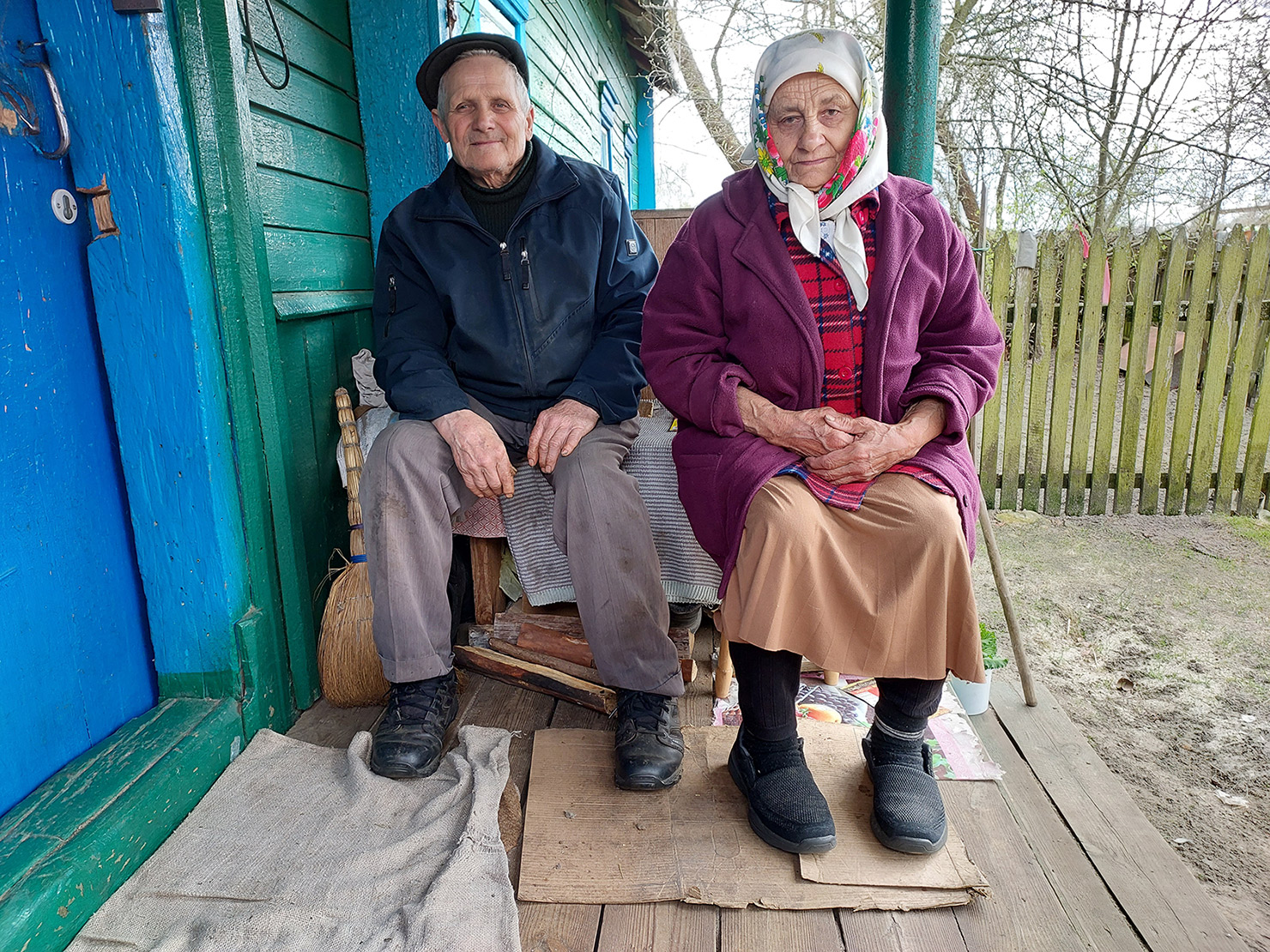
I had the chance to talk to Fedir and Mariia Bovkun, an elderly couple.
He was born in 1937, and she in 1940. Both survived the tragedy of 1943. Fedir was six years old at the time and remembers his uncle, a partisan from Saburov's unit, riding in on a horse. [Alexander Saburov was a leader of the Soviet partisan movement in Ukraine and western Russia during World War II – ed.] He just shouted "Get ready and run!" and went back to the forest. Mariia Yurkivna was not yet three, and she only knows from her parents' stories that her auntie, her mother's younger sister, carried her to the forest.
During this war, Fedir and Mariia did not go to the forest. They said they were too old and didn’t have the strength or agility for that, so they hid in the cellar.
The burgeoning villages of Polissia
Poznan, Berezove hromada, Rivne Oblast (right on the border with Belarus)
Here, the distance from the very furthest Ukrainian village within the Berezove hromada to the nearest Belarusian village is 7 km as the crow flies. There is a curious play on words in the names of these two settlements: the Ukrainian village is the namesake of the Polish city of Poznań, while the Belarusian village of Dzyarzhynsk bears the same name as Dzerzhinsk, a Russian city with a population of 200,000. This seems to be a kind of hint in Aesopian language [allegorical language used to bypass censorship – ed.], indicating who leans towards Europe, and who towards Russia.
Both villages are the two most remote settlements in the border areas of these two countries. Today, the Belarusian Dzyarzhynsk is in decline, with many abandoned houses and an ageing population, yet the Ukrainian Poznan is thriving. The old small huts and log cabins now compete with larger new-build houses that are unusual in these backwoods areas, and more and more of them are being built here every year.
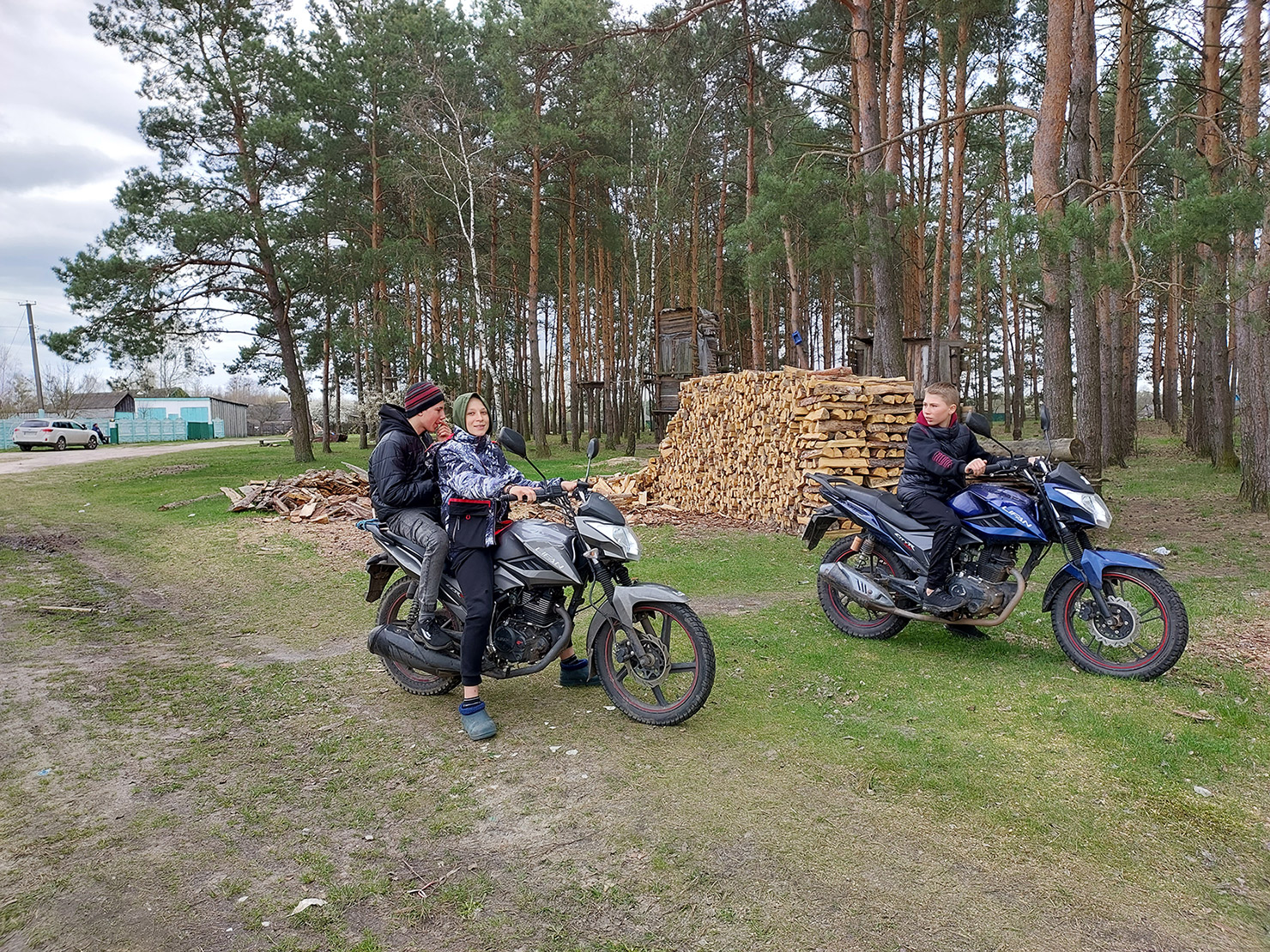
Almost the entire population of Poznan is made up of large families. On average, there are 6-8 children per family. But there are also a few record holders: three families in Poznan have 17 children.
At the school, which was built in 2010, there may be five, seven or even more children with the same surname in the same class. In fact, several children share the same full name – for example, there are two kids called Ivan Petrovych Kolodych (Vania for short). In this case, the teacher says "Vania Kolodych the first, please come up to the blackboard." Or Vania the second.
As the local administration told me, Poznan and the neighbouring village of Hlynne hold the [European] record for population growth due to fertility. Today 3,816 people live in Hlynne and 2,380 in Poznan. For comparison: according to the 2001 census, 2,257 people lived in Hlynne and 1,375 in Poznan.
What is the reason for this phenomenon? Probably religion: most people here are Christians. In addition to the Orthodox, there are communities of Evangelical Christians whose traditions encourage large families.
Jobs are scarce in the village itself, so people mostly travel elsewhere to earn money, usually on construction sites. Before, they used to go to Russia and Belarus; now they go to Europe. They often work as family teams.
People in Poznan say that "there are only pensioners and black huts left" in the villages on the Belarusian side. But there are more forests and pastures. Since Soviet times, Ukrainians had been able to enter Belarusian territory to gather mushrooms and berries, graze cattle, or set up beehives for summer honey collection.
But with the appearance of the state border and customs control, all that became a thing of the past. Honey that was personally harvested and taken across the border became an export and subject to customs duties. The same applied to milk from Ukrainian cows grazing on Belarusian lands.

For a long time, gathering mushrooms and forest berries and selling them to purchasers on the "other side" remained a profitable business for the people of Poznan. The licence cost US$130 per season, but the investment was quite quickly recouped. An experienced family team of several people could earn up to US$4,000 in the mushroom and berry picking season.
But all that stopped after 24 February 2022.
An employee of the Hlynne village district, which includes Poznan, told me last year, when fighting was already going on in Ukraine, that the Belarusian authorities had offered the villagers the chance to come and pick berries as before. But no one would: people were afraid of provocations. For example, you go to pick berries, and you’re caught and accused of being a saboteur.
Before the full-scale invasion, relations between the border guards of the two countries were quite normal, often even friendly. If two units met as they were coming out on duty, they’d walk in parallel on the two sides of the border, talking and sharing news. But now, they say, if two border guards pass each other, there is no greeting; they turn away from each other. No contact.
Poznan, like Kopyshche, was not occupied and its people heard the war only from afar. Of course, they could see the terrifying Moscow "war autographs": white trails from the missiles tearing across the grey sky.

Now the border is closed on both sides. I was told that a man from Belarusian Dzyarzhynsk arrived in Poznan the other day. He is a local Ukrainian, but he moved to Belarus with his wife many years ago. And now he’d come back for the days of remembrance. [In Orthodox Christianity, remembrance days are marked a week after the Resurrection of Christ at Easter; it is believed that at this time the souls of the dead find peace – ed.]
His journey was a long one, taking him through the whole of Belarus’s Brest Oblast to Poland, then through Poland to Ukraine’s Volyn Oblast, and from there to the neighbouring Rivne Oblast to reach his native Poznan. The journey meant crossing two state borders and took two days. Yet in 2018, just before Covid, it took him no more than an hour to travel back to his homeland for remembrance week, straight over on his bicycle…
***
When I left Polissia, it was newly awakened after the winter, blossoming and verdant. Full-flowing Polissia with its endless piles of firewood, its narrow roads where there are more timber trucks than cars, its sprawling villages where teenagers ride around in squadrons of motorbikes.
I had often heard the northern Ukrainian villages described as a wild land, a crowded backwoods where they can’t even name the current Ukrainian president because they get a better signal from Belarusian TV and only know Lukashenko.
But now I see that the "savagery" of the people of Polissia is far from the truth. These are modern people who drive new cars and have the latest devices. And they all realise who is their friend and who is their enemy. Since the outbreak of the war, the churches have been full to bursting – people, they say, have been praying for Ukraine. And they’re fighting for Ukraine in the east of the country just the same as people from other regions.
But certainly the treacherous collaboration between the Belarusian and Russian authorities has hit the Ukrainians of Polissia harder than any other Ukrainians. Because here the message about their "Belarusian brothers" was not bombastic rhetoric, but lived experience: not a metaphor, but reality.
Vadym Petrasiuk, for Ukrainska Pravda
Translated by Olya Loza, Myroslava Zavadska and Theodore Holmes
Edited by Teresa Pearce
